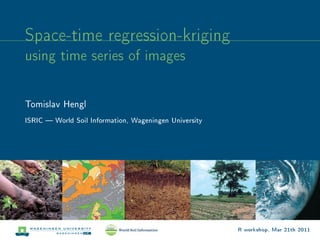
Space-time data workshop at IfGI
- 1. Space-time regression-kriging using time series of images Tomislav Hengl ISRIC World Soil Information, Wageningen University R workshop, Mar 21th 2011
- 2. TAAC paper R workshop, Mar 21th 2011
- 3. Space-time data Universal kriging model for spatio-temporal data (Heuvelink Grith, 2010): T (s, t) = m(s, t) + ε(s, t) (1) where m(s, t) is the deterministic part of the variation (i.e. a linear function of the auxiliary variables), ε(s, t) is the residual for every (s, t). R workshop, Mar 21th 2011
- 4. Space-time cube R workshop, Mar 21th 2011
- 5. Space-time semivariance γ(si , ti ; sj , tj ) = 0.5 · E ( (si , ti ) − (sj , tj ))2 (2) R workshop, Mar 21th 2011
- 6. Residuals Residuals ( ) consist of three stationary and independent components (Heuvelink Grith, 2010): (s, t) = s (s) + t (t) + s,t (s, t) (3) where s (s) is a purely spatial process (with constant realizations over time), t (t) is a purely temporal process, and s,t (s, t) is a space-time process for which distance in space is made comparable to distance in time by introducing a space-time anisotropy ratio. R workshop, Mar 21th 2011
- 7. Zonal anisotropies The covariance structure can be represented by (Snepvangers et al., 2003): C(h, u) = Cs (h) + Ct (u) + Cs,t ( h2 + (α + u)2 ) (4) where C(h, u) is the covariance at distance h in space, and time-distance u, Cs (h) + Ct (u) allow the presence of zonal anisotropies (dierent variogram sills in dierent directions), and Cs,t ( h2 + (α + u)2 ) allows the presence of geometric anisotropy represented with the ratio α. R workshop, Mar 21th 2011
- 8. The data set R workshop, Mar 21th 2011
- 9. In space-time cube cdays Y X R workshop, Mar 21th 2011
- 10. Variograms (separately) 365 days 159 stations 25 50 20 40 Semivariance Semivariance 15 30 10 20 10 5 0 0 0 50000 100000 150000 200000 0 10 20 30 40 50 60 Distance (m) Distance (in days) R workshop, Mar 21th 2011
- 11. Variograms (zonal anisotropy) ● ● ● 10 10 ● ● ● ● ● ● ● 8 8 ● ● ● semivariance semivariance ● 6 6 ● 4 ● 4 ● ● ● ● ● ● ● ● ● ● ● ● ● ● 2 ● 2 50000 100000 150000 200000 5 10 15 Distance (m) Distance (in days) Marginal experimental variograms for residuals and tted models: (left) space-domain only, (right) time-domain only. R workshop, Mar 21th 2011
- 12. Final results R workshop, Mar 21th 2011
- 13. Some experiences By adding the time component we are better o. R workshop, Mar 21th 2011
- 14. Some experiences By adding the time component we are better o. Automation of space-time regression-kriging (overlay, regression modeling, variogram tting, predictions, visualization in Google Earth) is anticipated. R workshop, Mar 21th 2011
- 15. Some experiences By adding the time component we are better o. Automation of space-time regression-kriging (overlay, regression modeling, variogram tting, predictions, visualization in Google Earth) is anticipated. Fitting and visualization of space-time variograms is a bottle-neck! R workshop, Mar 21th 2011
- 16. Some experiences By adding the time component we are better o. Automation of space-time regression-kriging (overlay, regression modeling, variogram tting, predictions, visualization in Google Earth) is anticipated. Fitting and visualization of space-time variograms is a bottle-neck! Predictions need to be visualized as animations. R workshop, Mar 21th 2011
- 17. Some experiences By adding the time component we are better o. Automation of space-time regression-kriging (overlay, regression modeling, variogram tting, predictions, visualization in Google Earth) is anticipated. Fitting and visualization of space-time variograms is a bottle-neck! Predictions need to be visualized as animations. We have ignored the one-way auto-correlation (time works only one way)? R workshop, Mar 21th 2011
- 18. Universal space-time reference Each observation should have by default: Longitude and latitude (WGS84) (or projected X, Y coordinates + proj4 string); Begin / end of the time interval in UTC (GMT) system; Support size (in square meters); Uncertainty or measurement error; R workshop, Mar 21th 2011
- 19. Space-time algebra re-visited Should we (re)dene and (re)implement space-time (4D) algebra? R workshop, Mar 21th 2011
- 20. What does this mean? Distances always on a sphere (sphere geometry); R workshop, Mar 21th 2011
- 21. What does this mean? Distances always on a sphere (sphere geometry); Always use information about uncertainty (weighted regression); R workshop, Mar 21th 2011
- 22. What does this mean? Distances always on a sphere (sphere geometry); Always use information about uncertainty (weighted regression); Always use information about the support size (nugget estimation, cross-validation); R workshop, Mar 21th 2011
- 23. What does this mean? Distances always on a sphere (sphere geometry); Always use information about uncertainty (weighted regression); Always use information about the support size (nugget estimation, cross-validation); Re-implement also any raster processing (geomorphometry, resampling, ltering etc); R workshop, Mar 21th 2011
- 24. What does this mean? Distances always on a sphere (sphere geometry); Always use information about uncertainty (weighted regression); Always use information about the support size (nugget estimation, cross-validation); Re-implement also any raster processing (geomorphometry, resampling, ltering etc); Use Google Earth to visualize any type of geographic data; R workshop, Mar 21th 2011
